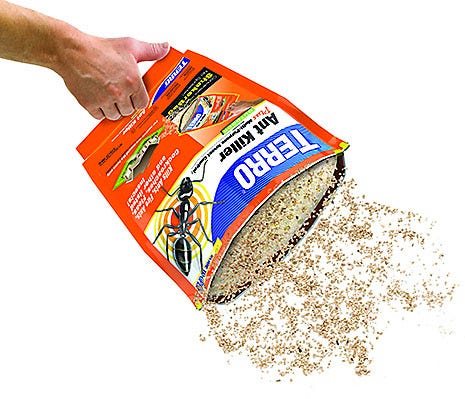Apply ant granules when ants are active and the soil is dry, typically during the warmer months. It’s best to treat in the evening or early morning.
Dealing with an ant infestation requires timely and effective measures. Ant granules are a popular choice for long-term control, working to eliminate colonies by targeting ants at the source. Timing is crucial; you want to catch these pests when they’re foraging for food.
Warmer weather usually corresponds with increased ant activity, making spring through to fall the prime time for application. Treating your outdoor spaces during the early part of this period can prevent ants from establishing strongholds. Applying granules during dry conditions helps ensure the product remains effective, as moisture can diminish its potency. Evening or morning treatments can be particularly successful since ant activity tends to be lower, and they are more likely to carry the granules back to their nests. Regular monitoring of your property can help identify the ideal window to apply ant granules, keeping your spaces ant-free.
The Best Times For Ant Granule Application
The Best Times for Ant Granule Application are crucial to effectively manage and eliminate ant infestations. Knowing when to deploy ant granules maximizes their potency, ensuring your efforts aren’t in vain. Let’s deep dive into the most opportune moments to apply these granules for maximum impact.
Seasonal Ant Activity Peaks
Ants exhibit patterns based on the seasons. Activity peaks can guide granule application timing for improved efficiency. Here’s what to look for:
- Spring: Ants emerge from hibernation to build colonies.
- Summer: Full-blown activity as ants forage for food and expand.
- Fall: Ants prepare for winter, seeking sustenance and shelter.
- Winter: Lower activity, but warm spells can cause brief surges.
Weather Conditions Favorable For Granules
To get the best out of ant granules, apply them under the right weather conditions. Here’s a snapshot of ideal granule weather:
| Weather Condition | Description |
|---|---|
| Dry Days | Moisture can compromise granule integrity. |
| Mild Temperatures | Too hot or cold can reduce granule effectiveness. |
| No Rain Forecast | Ensures granules remain in place to be effective. |
By aligning your ant granule application with these seasonal cues and weather guidelines, you’ll enhance your chances of maintaining an ant-free environment.
Pre-emptive Measures Against Ant Colonization
The war against ants begins before the first scout sets a feeler on your property. Ant granules offer a solid defense, setting up an invisible barrier that keeps these insects at bay. It’s a game of strategy, and timing is your best ally. To win against ant invasions, knowing when to apply ant granules is crucial.
Early Spring Applications
Spring heralds new beginnings, not just for plants but also for ant colonies. As temperatures rise, ants emerge to forage and build. Beating them to the punch with granules ensures your home remains a fortress against these persistent invaders.
- Inspect your property as winter wanes.
- Apply granules around the perimeter of your home.
- Focus on areas where ants are likely to enter.
Granules create a zone that ants avoid, preventing them from constructing nest sites nearby.
Prevention Vs. Treatment
Dealing with an active infestation is a challenge. Preventative measures save time and discomfort. Using ant granules before ants appear ensures they look elsewhere to establish their colonies.
| Prevention | Treatment |
|---|---|
| Apply ant granules early. | Deal with existing colonies. |
| Creates a protective barrier. | Requires more product and effort. |
| Ants seek other environments. | Disruption to daily life. |
Understanding Ant Life Cycles
Ants are fascinating creatures with complex life cycles. Knowing how these insects grow can guide us to effectively control them. Ant granules can disrupt these cycles, but the timing is crucial. We dive into ant development stages and ideal intervention points for applying ant granules.
Ant Development Stages
Ant colonies follow a distinct cycle:
- Egg: All ants start as eggs, laid by the queen.
- Larva: After hatching, they enter a larval stage, needing much food.
- Pupa: They then become pupae, resembling adults more closely.
- Adult: Finally, they emerge as adults, ready to work for the colony.
These stages form the core of their existence. Proper timing using ant granules can halt the cycle.
Ideal Intervention Points
The best times to apply ant granules hinge on two crucial stages:
- Early Larva: When larvae are young, they’re most vulnerable.
- Pre-Pupa: Treating before the pupa stage prevents new workers.
Apply ant granules during early spring or late winter. Ants are less active then, giving granules time to work. Briefly after rain also works, as ants rebuild their colonies, exposing them.

Credit: www.gardentech.com
Signs Indicating Need For Ant Granules
Ants are more than a nuisance; they can jeopardize both home and garden. Recognizing the time to deploy ant granules is pivotal for effective control. Keep a lookout for these clear indicators; they signal it’s time to take action.
Visual Presence Of Ants
An obvious sign that ant control is necessary is the direct observation of ants. If numerous ants are crawling throughout the house or garden, ant granules might be the solution. Frequent sightings in kitchens or along walls are red flags.
Spotting Ant Pathways
Trails of ants give away their presence. These pathways often lead to food sources or nests. Spotting such lines of ants regularly is a call to action. Interrupting these paths with ant granules can effectively disrupt their routine and protect the area.
Types Of Ant Granules And Their Applications
Combatting ant invasions requires the right tools for the job. Ant granules come into play here. They’re a potent and effective method to target these tiny intruders. Let’s dive into the variety of granules available.
Organic Versus Synthetic Options
Choosing between organic and synthetic ant granules depends on personal preference and environmental consideration.
- Organic options often contain natural ingredients like spinosad or diatomaceous earth.
- Synthetic granules feature man-made chemicals designed for ant control.
The former aligns with eco-friendly practices while the latter may offer more potent results. Check labels to ensure they meet your needs.
| Type | Ingredients | Environment Impact |
|---|---|---|
| Organic | Spinosad, Diatomaceous Earth | Low |
| Synthetic | Man-made Chemicals | Varies |
Targeted Granules For Specific Species
Not all ants are the same. Specific granules target different ant species.
- Fire ant granules are designed to eliminate aggressive invaders.
- Carpenter ant formulations tackle wood-destroying varieties.
Identify the ant species first for best results. Reference a guide or consult a professional as needed.
Effective pest control requires precise application. Use products as directed for optimal outcomes.
Applying Granules Effectively
Ant granules help control unwanted ant populations in your garden or lawn. Timing and technique are key for successful application. Learning to apply granules effectively saves time and ensures results.
Proper Dispersion Techniques
To spread ant granules evenly, use a spreader for large areas. Even coverage is crucial for eliminating ants. For smaller spaces, a hand-held shaker might work best. Follow these steps:
- Read the label for specific dispersal rates.
- Set your spreader to match the recommended setting.
- Walk at a steady pace to ensure uniform distribution.
- Overlap slightly on each pass to avoid gaps in coverage.
Safety Considerations And Ppe
When applying ant granules, personal safety is vital. Utilize personal protective equipment (PPE) to prevent exposure. This includes:
| PPE Item | Use |
|---|---|
| Gloves | Protect hands during application |
| Mask | Prevent inhalation of dust |
| Goggles | Shield eyes from granules |
Always keep children and pets away until granules are watered in and dry. Store unused granules in a locked area.
Timing The Reapplication Of Ant Granules
Welcome to our guide on the critical timing for reapplying ant granules to your garden or lawn. Getting this right means the difference between an ant-free area and a persisting problem. Let’s delve into how to track the effectiveness and decide on the frequency of your ant granule treatments.
Tracking Effectiveness Over Time
To maintain an ant-free space, monitor how well the granules work. It’s essential to note when the ants disappear after the initial application. Mark your calendar to observe when they might reappear. This information guides the timing of future treatments.
- Check the treated area regularly.
- Log ant activity in a journal or app.
- Adjust reapplication based on observations.
Frequency Of Treatment
Determining how often to apply ant granules depends on several factors. These include the product’s strength, the severity of the ant problem, and environmental conditions. Most products suggest reapplication every two months.
| Ant Severity | Mild Infestation | Severe Infestation |
|---|---|---|
| Initial Application | As recommended on label | As recommended on label |
| Reapplication | Every 2-3 months | Monthly |
| Notes | Adjust based on control success and weather. | |
For the best defense, combine ant granules with other control methods. Do not wait for the problem to worsen. Timely treatment is crucial to keeping your outdoor spaces ant-free.

Credit: www.terro.com
Impact Of Ant Granules On The Environment
When we use ant granules to protect our homes and gardens from pests, we must think about our planet too. Ant granules can affect soil, water and other creatures. Knowing the impact on the environment helps us make better choices.
Ecological Considerations
Ant granules are not selective. They can harm non-target species. Bees, worms and beneficial insects can suffer. These creatures are critical for healthy ecosystems. Rain can wash these granules into streams or rivers. This can harm fish and water plants.
- Avoid overuse: Use the correct amount to limit environmental impact.
- Timing is key: Apply during dry weather to prevent runoff.
- Targeted application: Place granules near ant mounds, away from water sources.
Choosing Eco-friendly Products
Selecting ant control products with care is crucial. Look for options labeled as eco-friendly or organic. These products break down naturally and pose less threat to the environment. Below is a guide to help choose safer alternatives.
| Features | Benefits |
|---|---|
| Natural ingredients | Less toxic to non-target species |
| Biodegradable | Breaks down without harming the environment |
| Non-toxic | Safe for children and pets when used as directed |
Common Mistakes To Avoid
Effective pest control calls for precision. Let’s explore some typical blunders to sidestep when using ant granules.
Overapplication Issues
Many believe more is better, leading to overusing ant granules. This approach can cause several setbacks:
- Danger to beneficial insects
- Potential environmental harm
- Waste of product and money
Keep applications moderate and targeted to avoid these pitfalls.
Ignoring Manufacturer’s Instructions
Overlooking the manual is a big no. Here’s why:
- Safety risks increase with misuse
- Ant granule effectiveness decreases
- There’s a risk of legal repercussions
Always follow the guide provided to ensure optimal results and safety.

Credit: www.amazon.com
Professional Pest Control Advice
Seeking professional pest control advice is key when dealing with ant issues. This is especially true if you’ve tried DIY methods with little success. Experts possess not only the right tools but also the knowledge to deal with infestations effectively.
When To Consult A Professional
You should seek professional advice when:
- The ant problem persists despite using ant granules.
- Ants are causing damage to your property.
- You’re experiencing repeat infestations.
A professional exterminator can identify the ant species. They then use targeted treatments to solve the issue.
Benefits Of Expert Intervention
Professional pest control provides several benefits:
- Efficient pest identification ensures correct treatment application.
- An expert can prevent future infestations with strategic measures.
- Safety is paramount; professionals use products correctly to protect your family and pets.
Professionals save you time and alleviate the frustration of recurring ant problems.
Frequently Asked Questions Of When To Apply Ant Granules
When Should I Apply Ant Granules?
Ant granules are best applied in early spring or late summer. This is when ants are most active and foraging. Timing is crucial for the granules to be effective.
Can Ant Granules Be Used Indoors?
Ant granules are formulated for outdoor use to target ant colonies. They are not suitable for indoor use due to potential toxicity and ineffectiveness within a home environment.
How Long Do Ant Granules Take To Work?
Ant granules typically start working within 24 hours. However, it may take up to several weeks to see a significant reduction in ant activity as the granules disrupt the colony.
Do Ant Granules Work In Rainy Weather?
Ant granules are weather-resistant but heavy rain can wash them away. Apply them when the forecast is dry for at least 24-48 hours to ensure they penetrate the soil and reach the ants.
Conclusion
Applying ant granules at the right time is crucial for effective pest control. Aim for early spring or when activity peaks to tackle infestations. By following the advice shared, you’ll ensure a healthier, ant-free garden. Remember, consistent treatment yields the best results.
Protect your outdoor space with timely applications.

I’m MD Tanvir, and I bring years of expertise gained from working closely with pest control companies to the forefront. My journey in the industry has inspired me to launch Bug Battler, a platform aimed at equipping people with the know-how to combat pests autonomously. Through Bug Battler, I aim to empower individuals with practical insights to tackle pest infestations effectively.

